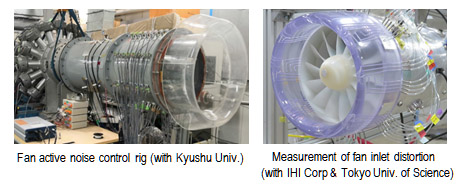Research & Development
JAXA promotes three research and development programs and a fundamental research program that underpins them.
Aeroengine noise reduction technology
The noise reduction requires two studies. One is to understand the aero and acoustic phenomenon of each sound source. The other is to propose and verify the noise reduction technologies obtained by the understanding of the sound sources. Experimental works with acoustic test facilities and a small jet engine are conducted together with computational works.
Jet noise
Numerical simulation is applied to understand the effect of noise reduction devices against jet noise. Experiment using subscale models and jet engines evaluates the acoustic and aerodynamic performances of the devices. Visualization by a phased array microphone system or an optical equipment helps understand generation and propagation of sound.

Fan noise
Numerical simulation and experiment are conducted to investigate the fan noise and the inlet distortion. A fan rig realizes active control of fan tones by the anti-phased secondary sound sources. Inlet distortion to fans is measured by a small fan rig.

Acoustic liners
Passive or active acoustic liners attenuate sound generated from fans and cores of engines. Findings according to numerical simulations are reflected to better liner designs. Flow duct rig evaluate the acoustic properties of the liners under grazing conditions.

Engine test
Noise tests are conducted using a small turbofan engine. The mixer nozzles and acoustic liner panels have been applied to the engine. Acoustic properties of these noise reduction devices are evaluated together with engine performances.


March 31, 2020